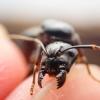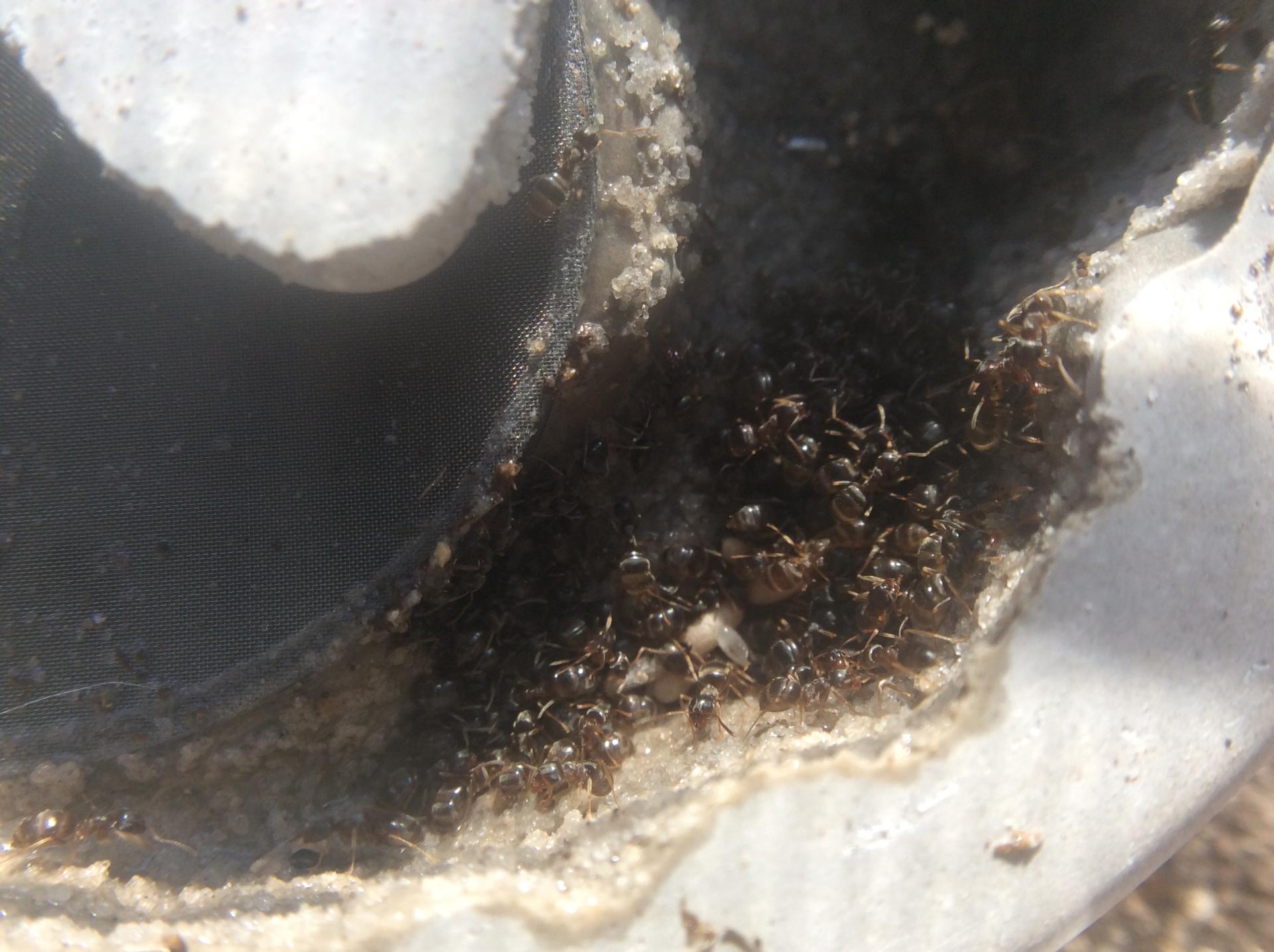- Formiculture.com
- Forums
- Gallery
- Members
- Member Map
- Chat

Do all Honeypot Ants Have Repletes
Started By
TechAnt
, Jun 13 2020 3:21 PM
27 replies to this topic
#1
 Offline
-
Posted June 13 2020 - 3:21 PM
Offline
-
Posted June 13 2020 - 3:21 PM
This may be a dumb question, as ants in the honeypot genus probably all have repletes, since that is what their genus is named for. But I will ask anyways, do all honeypots have repletes?
My Ants:
(x1) Campontous semitstaceus ~20 workers, 1 Queen
(x1) Camponotus vicinus ~10 workers, 1 Queen (all black variety)
(x1) Tetramorium immigrans ~100 workers, 1 Queen
(x1) Myrmercocystus mexicanus -1 Queen
(x2) Mymercocystus mimcus -1 Queen
(x1) Mymercocystus testaceus ~45 workers, 1 Queen
(x1) Campontous semitstaceus ~20 workers, 1 Queen
(x1) Camponotus vicinus ~10 workers, 1 Queen (all black variety)
(x1) Tetramorium immigrans ~100 workers, 1 Queen
(x1) Myrmercocystus mexicanus -1 Queen
(x2) Mymercocystus mimcus -1 Queen
(x1) Mymercocystus testaceus ~45 workers, 1 Queen
#2
 Offline
-
Posted June 13 2020 - 4:35 PM
Offline
-
Posted June 13 2020 - 4:35 PM
To my knowledge, yes. If there are any species who didn’t, they must be pretty rare.
- TechAnt likes this
"God made..... all the creatures that move along the ground according to their kinds (including ants). And God saw that it was good. Genesis 1:25 NIV version
Keeping:
Formica cf. pallidefulva, cf. incerta, cf. argentea
Formica cf. aserva, cf. subintegra
Myrmica sp.
Lasius neoniger, brevicornis
#3
 Offline
-
Posted June 13 2020 - 7:08 PM
Offline
-
Posted June 13 2020 - 7:08 PM
To my knowledge, yes. If there are any species who didn’t, they must be pretty rare.
Ah, thanks.
My Ants:
(x1) Campontous semitstaceus ~20 workers, 1 Queen
(x1) Camponotus vicinus ~10 workers, 1 Queen (all black variety)
(x1) Tetramorium immigrans ~100 workers, 1 Queen
(x1) Myrmercocystus mexicanus -1 Queen
(x2) Mymercocystus mimcus -1 Queen
(x1) Mymercocystus testaceus ~45 workers, 1 Queen
(x1) Campontous semitstaceus ~20 workers, 1 Queen
(x1) Camponotus vicinus ~10 workers, 1 Queen (all black variety)
(x1) Tetramorium immigrans ~100 workers, 1 Queen
(x1) Myrmercocystus mexicanus -1 Queen
(x2) Mymercocystus mimcus -1 Queen
(x1) Mymercocystus testaceus ~45 workers, 1 Queen
#4
 Offline
-
Posted June 13 2020 - 7:10 PM
Offline
-
Posted June 13 2020 - 7:10 PM
Most ants have repletes actually, pretty much all formicines and dolichoderines and some myrmicines. Perhaps some ponerines as well, I'm not certain on any other subfamilies but it is likely.
- RushmoreAnts likes this
#5
 Offline
-
Posted June 13 2020 - 10:04 PM
Offline
-
Posted June 13 2020 - 10:04 PM
Took this from antweb. Take from it what you will. It's just a hypothesis anyways.
"Creighton (1950) ventured the opinion that replete production was a matter of opportunity, rather than an innate, physiological phenomenon. He further offered the idea that replete production is not a response to arid desert conditions but rather that it is the result of a previous xerophile having invaded less rigorous climes. In other words, replete production is the result of the availability of an excessive amount of nectar available in mesophytic environments."
The trademark honeypot repletes that you see are not filled with protein or fat but really only store sugars. Most of the species or variants that have been found to have repletes are also exclusively insectivores. Myrmecocystus is an extremely understudied genus, and from what I've read on antweb, whether honeypots make repletes is determined by the location where they were caught, as there are species of Myrmecocystus where replete production is completely absent in some locations but found in others.
That being said, it seems like the honey pots which are not physiologically used to making repletes do still have some sort of capability to do so.
- RushmoreAnts, OhNoNotAgain and TechAnt like this
Website: https://sites.google...home?authuser=0
Instagram: https://www.instagra.../bay.area.ants/
Youtube Channel: https://www.youtube....5Mh2eBAviuO2uw?
#6
 Offline
-
Posted June 13 2020 - 10:18 PM
Offline
-
Posted June 13 2020 - 10:18 PM
I was asking this cause I am thinking about getting some M. Mimicus when available, and I wanted to know if they had the repletes that make the genus famous, this was helpful.
My Ants:
(x1) Campontous semitstaceus ~20 workers, 1 Queen
(x1) Camponotus vicinus ~10 workers, 1 Queen (all black variety)
(x1) Tetramorium immigrans ~100 workers, 1 Queen
(x1) Myrmercocystus mexicanus -1 Queen
(x2) Mymercocystus mimcus -1 Queen
(x1) Mymercocystus testaceus ~45 workers, 1 Queen
(x1) Campontous semitstaceus ~20 workers, 1 Queen
(x1) Camponotus vicinus ~10 workers, 1 Queen (all black variety)
(x1) Tetramorium immigrans ~100 workers, 1 Queen
(x1) Myrmercocystus mexicanus -1 Queen
(x2) Mymercocystus mimcus -1 Queen
(x1) Mymercocystus testaceus ~45 workers, 1 Queen
#7
 Offline
-
Posted June 13 2020 - 11:13 PM
Offline
-
Posted June 13 2020 - 11:13 PM
In my opinion mimicus die the most.
I love Camponotus!
Old Shop: https://www.formicul...-stallbay-area/
Current Shop: https://www.formicul...17962-ant-dump/
#8
 Offline
-
Posted June 13 2020 - 11:44 PM
Offline
-
Posted June 13 2020 - 11:44 PM
In my opinion mimicus die the most.
Have you kept them before?
My Ants:
(x1) Campontous semitstaceus ~20 workers, 1 Queen
(x1) Camponotus vicinus ~10 workers, 1 Queen (all black variety)
(x1) Tetramorium immigrans ~100 workers, 1 Queen
(x1) Myrmercocystus mexicanus -1 Queen
(x2) Mymercocystus mimcus -1 Queen
(x1) Mymercocystus testaceus ~45 workers, 1 Queen
(x1) Campontous semitstaceus ~20 workers, 1 Queen
(x1) Camponotus vicinus ~10 workers, 1 Queen (all black variety)
(x1) Tetramorium immigrans ~100 workers, 1 Queen
(x1) Myrmercocystus mexicanus -1 Queen
(x2) Mymercocystus mimcus -1 Queen
(x1) Mymercocystus testaceus ~45 workers, 1 Queen
#9
 Offline
-
Posted June 14 2020 - 3:45 AM
Offline
-
Posted June 14 2020 - 3:45 AM
As mentioned there are several Myrmecocystus species for which repletes are not known, additionally protein and water filled repletes are fairly common. You do not want to taste one of the protein filled repletes.
- Antennal_Scrobe and RushmoreAnts like this
#10
 Offline
-
Posted June 14 2020 - 4:38 AM
Offline
-
Posted June 14 2020 - 4:38 AM
Why, did you?As mentioned there are several Myrmecocystus species for which repletes are not known, additionally protein and water filled repletes are fairly common. You do not want to taste one of the protein filled repletes.
- RushmoreAnts likes this
#11
 Offline
-
Posted June 14 2020 - 4:38 AM
Offline
-
Posted June 14 2020 - 4:38 AM
Nah, I’m good.As mentioned there are several Myrmecocystus species for which repletes are not known, additionally protein and water filled repletes are fairly common. You do not want to taste one of the protein filled repletes.
- RushmoreAnts likes this
"The ants are a people not strong, yet they prepare their meat in the summer." Prov. 30:25
Keep ordinary ants in extraordinary ways.
Keep ordinary ants in extraordinary ways.
#12
 Offline
-
Posted June 14 2020 - 8:27 AM
Offline
-
Posted June 14 2020 - 8:27 AM
I have a nearly 1 year old M. mexicanus colony and they make protein repletes. Only way I can tell that they're protein laden repletes is every time I feed blood worm soup one or two new repletes pop up filled with the black colored blood worm soup. Also, it seems whenever they are in a mode where repletes are being drained its always the bloodworm filled ones that get used first.
- RushmoreAnts likes this
#13
 Offline
-
Posted June 14 2020 - 9:29 AM
Offline
-
Posted June 14 2020 - 9:29 AM
Wait wait, I am confused now. When saying ‘repletes are not known’ does that mean some/most don’t have the trademark sugar filled repletes?As mentioned there are several Myrmecocystus species for which repletes are not known, additionally protein and water filled repletes are fairly common. You do not want to taste one of the protein filled repletes.
To narrow this down, does M. Mimicus have the trademark sugary repletes and/or protein repletes?
Edited by TechAnt, June 14 2020 - 9:30 AM.
My Ants:
(x1) Campontous semitstaceus ~20 workers, 1 Queen
(x1) Camponotus vicinus ~10 workers, 1 Queen (all black variety)
(x1) Tetramorium immigrans ~100 workers, 1 Queen
(x1) Myrmercocystus mexicanus -1 Queen
(x2) Mymercocystus mimcus -1 Queen
(x1) Mymercocystus testaceus ~45 workers, 1 Queen
(x1) Campontous semitstaceus ~20 workers, 1 Queen
(x1) Camponotus vicinus ~10 workers, 1 Queen (all black variety)
(x1) Tetramorium immigrans ~100 workers, 1 Queen
(x1) Myrmercocystus mexicanus -1 Queen
(x2) Mymercocystus mimcus -1 Queen
(x1) Mymercocystus testaceus ~45 workers, 1 Queen
#14
 Offline
-
Posted June 14 2020 - 9:58 AM
Offline
-
Posted June 14 2020 - 9:58 AM
Well, according to a photo in this article mimicus can have repletes?
However, I've heard some people say they don't. And apparently people can misidentify them. AND it probably varies by location and circumstance.
And honeypots apparently like to die.
In other words, you won't know for sure and may never find out. lol
https://theconversat...y-makers-102838
Edited by OhNoNotAgain, June 14 2020 - 9:59 AM.
Formiculture Journals::
Veromessor pergandei, andrei; Novomessor cockerelli
Camponotus fragilis; also separate journal: Camponotus sansabeanus (inactive), vicinus, laevigatus/quercicola
Liometopum occidentale; Prenolepis imparis; Myrmecocystus mexicanus (inactive)
Pogonomyrmex subnitidus and californicus (inactive)
Tetramorium sp.
Termites: Zootermopsis angusticollis
Isopods: A. gestroi, granulatum, kluugi, maculatum, vulgare; C. murina; P. hoffmannseggi, P. haasi, P. ornatus; V. parvus
Spoods: Phidippus sp.
#15
 Offline
-
Posted June 14 2020 - 10:08 AM
Offline
-
Posted June 14 2020 - 10:08 AM
Well, according to a photo in this article mimicus can have repletes?
However, I've heard some people say they don't. And apparently people can misidentify them. AND it probably varies by location and circumstance.
And honeypots apparently like to die.
In other words, you won't know for sure and may never find out. lol
https://theconversat...y-makers-102838
CONFUSION 100
My Ants:
(x1) Campontous semitstaceus ~20 workers, 1 Queen
(x1) Camponotus vicinus ~10 workers, 1 Queen (all black variety)
(x1) Tetramorium immigrans ~100 workers, 1 Queen
(x1) Myrmercocystus mexicanus -1 Queen
(x2) Mymercocystus mimcus -1 Queen
(x1) Mymercocystus testaceus ~45 workers, 1 Queen
(x1) Campontous semitstaceus ~20 workers, 1 Queen
(x1) Camponotus vicinus ~10 workers, 1 Queen (all black variety)
(x1) Tetramorium immigrans ~100 workers, 1 Queen
(x1) Myrmercocystus mexicanus -1 Queen
(x2) Mymercocystus mimcus -1 Queen
(x1) Mymercocystus testaceus ~45 workers, 1 Queen
#16
 Offline
-
Posted June 14 2020 - 10:36 AM
Offline
-
Posted June 14 2020 - 10:36 AM
Well uh, this thread taught me something-ish?
My Ants:
(x1) Campontous semitstaceus ~20 workers, 1 Queen
(x1) Camponotus vicinus ~10 workers, 1 Queen (all black variety)
(x1) Tetramorium immigrans ~100 workers, 1 Queen
(x1) Myrmercocystus mexicanus -1 Queen
(x2) Mymercocystus mimcus -1 Queen
(x1) Mymercocystus testaceus ~45 workers, 1 Queen
(x1) Campontous semitstaceus ~20 workers, 1 Queen
(x1) Camponotus vicinus ~10 workers, 1 Queen (all black variety)
(x1) Tetramorium immigrans ~100 workers, 1 Queen
(x1) Myrmercocystus mexicanus -1 Queen
(x2) Mymercocystus mimcus -1 Queen
(x1) Mymercocystus testaceus ~45 workers, 1 Queen
#17
 Offline
-
Posted June 14 2020 - 11:21 AM
Offline
-
Posted June 14 2020 - 11:21 AM
I was asking this cause I am thinking about getting some M. Mimicus when available, and I wanted to know if they had the repletes that make the genus famous, this was helpful.
Myrmecocystus mimicus as defined by Wheeler 100 years ago does make repletes. However, Myrmecocystus lomaensis, which is nearly identical to mimicus does not make repletes. In fact, I'm pretty sure the distinction between the two species was made solely on whether they could or couldn't make repletes. In 1950, it was found that some M. mimicus have exactly the same physiological differences as M. lomaensis which are supposed to distinguish M. lomaensis from M. mimicus.
So... I would recommend just getting something other than mimicus
- OhNoNotAgain likes this
Website: https://sites.google...home?authuser=0
Instagram: https://www.instagra.../bay.area.ants/
Youtube Channel: https://www.youtube....5Mh2eBAviuO2uw?
#18
 Offline
-
Posted June 14 2020 - 1:13 PM
Offline
-
Posted June 14 2020 - 1:13 PM
My Lasius and Formica make repletes...........Most ants have repletes actually, pretty much all formicines and dolichoderines and some myrmicines. Perhaps some ponerines as well, I'm not certain on any other subfamilies but it is likely.
Edited by AntsDakota, June 14 2020 - 1:13 PM.
"God made..... all the creatures that move along the ground according to their kinds (including ants). And God saw that it was good. Genesis 1:25 NIV version
Keeping:
Formica cf. pallidefulva, cf. incerta, cf. argentea
Formica cf. aserva, cf. subintegra
Myrmica sp.
Lasius neoniger, brevicornis
#19
 Offline
-
Posted June 14 2020 - 2:36 PM
Offline
-
Posted June 14 2020 - 2:36 PM
Myrmecocystus lomaensis, is a synonym of mimicus, in other words same ant. All "not known to make repletes" means is that they have not yet been found in a nest which means the investigator/collector did not dig deep or extensively enough. Although other ants make repletes they are generally not on the scale of Myrmecocystus, semi replete is more accurate.
#20
 Offline
-
Posted June 14 2020 - 5:19 PM
Offline
-
Posted June 14 2020 - 5:19 PM
Do M. tenuinodis or M. testaceus have the trademark repletes? As people seem to be saying Mimicus does not.
My Ants:
(x1) Campontous semitstaceus ~20 workers, 1 Queen
(x1) Camponotus vicinus ~10 workers, 1 Queen (all black variety)
(x1) Tetramorium immigrans ~100 workers, 1 Queen
(x1) Myrmercocystus mexicanus -1 Queen
(x2) Mymercocystus mimcus -1 Queen
(x1) Mymercocystus testaceus ~45 workers, 1 Queen
(x1) Campontous semitstaceus ~20 workers, 1 Queen
(x1) Camponotus vicinus ~10 workers, 1 Queen (all black variety)
(x1) Tetramorium immigrans ~100 workers, 1 Queen
(x1) Myrmercocystus mexicanus -1 Queen
(x2) Mymercocystus mimcus -1 Queen
(x1) Mymercocystus testaceus ~45 workers, 1 Queen
0 user(s) are reading this topic
0 members, 0 guests, 0 anonymous users
























